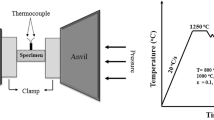Abstract
The dynamic elastic limit and spall strength of high-alloy chromium-manganese-nickel steel in the martensitic-austenitic transformation induced by a change in the temperature from −120 to 200°C is measured by recording the complete wave profiles with a VISAR laser interferometer and subsequently analyzing them. The spall strength of the investigated steel in the martensitic phase is found to be 25–30% higher than the strength of steel in the austenitic phase. In this case, the strength decreases in a stepwise manner in a narrow temperature range approximately from −50 to 20°C, where, apparently, basic changes in the internal structure of steel occur due to the martensitic-austenitic transformation. The measured values of the dynamic elastic limit of high-alloy steel have a sufficiently large scatter and hardly decrease with increasing temperature without any features associated with the martensitic-austenitic transformation of the structure.
Similar content being viewed by others
References
G. B. Olson and M. Cohen, “A General Mechanism of Martensitic Nucleation: Part II. FCC-BCC and Other Martensitic Transformations,” Metallurg. Trans. A 7, 1905–1913 (1976).
V. F. Zackay, E. R. Parker, D. Fahr, and R. Busch, “The Enhancement of Ductility in High-Strength Steels,” Trans. ASM 60, 252–259 (1967).
I. Tamura, “Deformation-Induced Martensitic Transformation and Transformation-Induced Plasticity in Steels,” Metal Sci. 16, 245–253 (1982).
J. R. Patel and M. Cohen, “Criterion for the Action of Applied Stresses in the Martensitic Transformation,” Acta Metallurg. 1, 531–538 (1953).
T. Angel, “Formation of Martensite in Austenitic Stainless Steels,” J. Iron Steel Inst., No. 5, 165–174 (1954).
A. Wei “Deformation Induced Martensite Formation and Its Effect on Transformation Induced Plasticity (TRIP),” Steel Res. Int. 77, 727–732 (2006).
G. Frommeyer and P. Neumann, “Supra-Ductile and High Strength Manganese-TRIP/TWIP Steels for High Energy Absorption Purposes,” ISIJ Int. 43, 438–446 (2003).
L. Remy and A. Pineau, “Twinning and Strain-Induced FCC-HCP Transformation in the Fe-Mn-Cr-C System,” Mater. Sci. Eng. 28, 99–107 (1977).
K. Sato, M. Ichinose, Y. Hirotsu, and Y. Inoue, “Effects of Deformation Induced Phase Transformation and the Mechanical Properties of Austenitic Fe-Mn-Al Alloys,” ISIJ Int. 29, 868–877 (1989).
G. B. Olson and M. Cohen, “A General Mechanism of Martensitic Nucleation: Part I. General Concepts and the FCC-HCP Transformation,” Metallurg. Trans. A 7, 1897–1904 (1976).
G. I. Kanel’, S. V. Razorenov, A. V. Utkin, and V. E. Fortov, Shock-Wave Phenomena in Condensed Matter (Yanus-K, Moscow, 1996) [in Russian].
L. M. Barker and R. E. Hollenbach, “Laser Interferometry for Measuring High Velocities of Any Reflecting Surface,” J. Appl. Phys. 43, 4669–4675 (1972).
S. P. Marsh, LASL Shock Hugoniot Data (Univ. of California Press, Berkeley, 1980).
G. I. Kanel’, “Distortion of the Wave Profiles in an Elastoplastic Body upon Spalling,” Prikl. Mekh. Tekh. Fiz. 42(2), 194–198 (2001) [J. Appl. Mech. Tech. Phys. 42 (2), 358–362 (2001)].
G. I. Kanel, S. V. Razorenov, K. Baumung, and J. Singer, “Dynamic Yield and Tensile Strength of Aluminum Single Crystals at Temperatures up to the Melting Point,” J. Appl. Phys. 90(1), 136–143 (2001).
G. I. Kanel, S. V. Razorenov, A. A. Bogatch, A. V. Utkin, V. E. Fortov, and D. E. Grady, “Spall Fracture Properties of Aluminum and Magnesium at High Temperatures,” J. Appl. Phys. 79(11), 8310–8317 (1996).
G. I. Kanel, S. V. Razorenov, and V. E. Fortov, “Shock-Wave Compression and Tension of Solids at Elevated Temperatures: Superheated Crystal States, Premelting, and Anomalous Growth of the Yield Strength,” J. Phys.: Condensed Matter 16(14), S1007–S1016 (2004).
L. Krüger, L. Meyer, S. V. Razorenov, and G. I. Kanel,, “Investigation of Dynamic Flow and Strength Properties of Ti-6-22-22S at Normal and Elevated Temperatures,” Int. J. Impact. Eng. 28(8), 877–890 (2003).
S. V. Razorenov, G. V. Garkushin, G. I. Kanel, O. A. Kashin, and I. V. Ratochka, “Behavior of the Nickel-Titanium Alloys with the Shape Memory Effect Under Conditions of Shock Wave Loading,” Phys. Solid State 53(4), 824–829 (2011).
Author information
Authors and Affiliations
Corresponding author
Additional information
Original Russian Text © A.S. Savinykh, G.V. Garkushin, S.V. Razorenov, S. Wolf, L. Kruger.
__________
Translated from Fizika Goreniya i Vzryva, Vol. 51, No. 1, pp. 143–149, January–February, 2015.
Rights and permissions
About this article
Cite this article
Savinykh, A.S., Garkushin, G.V., Razorenov, S.V. et al. Influence of the temperature-induced martensitic-austenitic transformation on the strength properties of high-alloy steels under dynamic loading. Combust Explos Shock Waves 51, 124–129 (2015). https://doi.org/10.1134/S001050821501013X
Received:
Published:
Issue Date:
DOI: https://doi.org/10.1134/S001050821501013X



